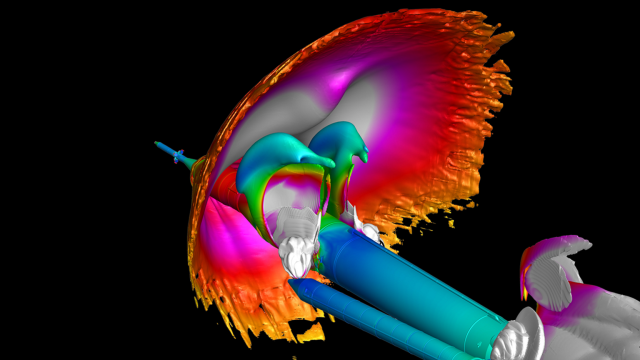NASA’s new Space Launch System is going to be the first to carry astronauts beyond low Earth orbit since Saturn V went into space — but it will also carry 10 per cent more payload. That’s giving its engineers an awful lot of maths to worry about, and this is what their work looks like.
A team at the space agency are using computational fluid dynamics simulations to understand the aerodynamics of the new craft. It’s a familiar design: there’s a central core with two solid rocket boosters strapped to the sides. Two minutes after launch, 16 separation motors are used to separate the boosters from the side. You’ve seen it hundreds of times; it’s iconic.
But the forces generated during that kind of operation are immense and, when you’re trying to push 10 per cent more stuff into space than you have done before, hard to predict. Hence all this maths.
NASA explains that it’s been using a computational fluid dynamics package called Cart3D — which was actually developed by NASA — to calculate the aerodynamic forces on the system during launch. Their calculations are complext to say they least. They take into account 22 different sources of thrust: plooms from the two boosters, the four core-stage engines, and 16 booster separations motors.

NASA explains what you can see in this image: The transparent surfaces show the shock waves in the incoming air as it encounters the vehicle and the forward booster-separation motor plumes (shown in red). The vehicle surface is coloured by pressure.
They work across eight independent variables, which NASA lists as “three translation variables and two rotation variables to define the booster position and orientation relative to the core, the free-stream angle of attack and angle of side-slip of the core, and the relative thrust of the booster-separation motors.” And then, just to be safe, they also run separate simulations to assess what happens if one of the sources of thrust fails.
All in, the team has so far run 22,000 different simulations to work out how the aerodynamics of the craft works during takeoff. Perhaps understandably, the simulations had to be run on the Pleiades supercomputer at the NASA Advanced Supercomputing facility at Ames Research Center. These kinds of results, which were presented at NASA’s recent supercomputing conference, will be added to a huge database of work used to assess the behaviour of Space Launch System.
[NASA]
Images by Stuart Rogers, NASA/Ames; Ryan Rocha, University of California, Davis
